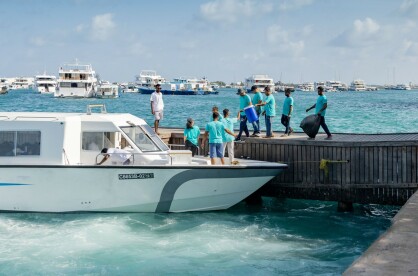When Elon Musk, the pioneer of Tesla as well as SpaceX, two companies that have been changing the world at an unprecedented rate, announced his plans for globalised internet accessibility, most people were quick to jump on the bandwagon. Here is a billionaire who seems to be taking the most outrageous risks, making the boldest of claims and then coming close to even seeing them through; so his newest idea was quickly lapped up by his ‘heart-eyed’ followers internationally, including by Maldivians.
The key difference that makes his venture truly standout is how the internet will not be provided through hardware such as fibre or the outdated ADSL system, but by satellites. 30,000 of them, as is claimed, in a constellation around the globe in low orbit, providing internet for anyone with a receiving dish and router plugged in. The possibility in speed is between 30 to 100 megabits per second (not to be confused with megabytes), with no data cap, and a fixed monthly fee. From anywhere in the world.
This, is Starlink.
When Maldivians consider their geographic uniqueness, this might sound a little too good to be true. A population spread over 200 inhabited islands, the current telecom giants aren’t investing nearly enough to establish an equally powerful internet connection for every single citizen. While mobile connections are now at the highest penetration rates they have ever been at, the infrastructure costs for domestic connections are considered not worth the prospected profit, which is what has caused the digital divide in the nation. Starlink, however, brings in an entirely new, and globally empowered alternative, with a pricing that does not require two and a half years of silent, closed-door lobbying to bring about. This may be what the Maldives has deserved from the very start.
In short, once you subscribe to their service, Starlink sends over a dish antennae, 100 feet of PoE cabling, a power supply box and a router. You are then tasked with the simple process of placing the dish in the appropriate position, connect the wires, setup the router and then get surfing. So far, it does seem too good to be true. Here are some of the details that are not usually mentioned when one talks about Starlink.
Starlink is based on an array, or constellation as the company prefers to call it, of low-orbit satellites constantly flying across the sky, which bounce the signal off of your dish and back to provide the connection. These satellites are being constantly launched by reusable SpaceX Falcon 9 orbital rockets - another amazing achievement by Musk and friends. When boasting consistent speeds of up to 100Mbps, all this depends on satellite availability in the sky, and there are some key factors to consider in this.
First of all, the dish you place requires a cone of at least 100 degrees of clear, unobstructed view of the sky. Yes, trees, roofs, and even telephone poles have an effect on the connection. This is because the dish will first calibrate to the nearest available satellite, compile the orbital schedule, and then trace each satellite that comes into view. If the view is obstructed, the service will not be ideal for the entire day. This is not something Maldivians are unaccustomed to already, but for such a futuristic venture, this does bode concerns.
Secondly, the number of satellites currently in orbit are not even close to covering the globe to provide uninterrupted connectivity. As of this year, there are 1700 in orbit, only enough to provide connectivity just for North American consumers, where they have reached more than 10,000 customers. Yet, even from the initial reviews, interested parties are warned not to expect normal internet usage.
For obvious reasons, a fibre connection would be a lot faster, in terms of speed and latency, and latency has been a limiting factor for Starlink. Using the connection for services that require buffering has been satisfying, such as Netflix and Youtube, with only a slight issue when quickly scrolling through TikTok and other smaller applications. However, reviewers claim that usage that requires consistent connectivity, such as video conferences, gaming and streaming, creates issues.
Regardless, the Maldives is actually a prime candidate for Starlink - it is a country of flat land, and townships have accessibility to clear, unobstructed skies. Added to that, the climate is most forgiving when compared to a majority of US locations, with no risk of snowfall or extended low visibility. While the latency and speed is described as 20 - 40 ms and 50 - 150 Mbps respectively, Musk has stated that he expects the speeds to double to 300 Mbps by the end of this year.
The induction of Starlink as a competitor in the Maldivian telecommunications market is currently allowed, as per the latest statements from relevant authorities. The price ranges and the lack of a data cap, added to the fact that service will be consistent wherever one is located in the nation, this has the possibility of entirely disrupting the current status quo.
Any economist would warn interested consumers that the government will most certainly step in, as both the telecom giants already here have their hands quite deep in the administrations pockets. What could be expected is high tariffs to make the price difference favourable for the incumbent companies, or licensing fees for using SpaceX as an individual. There are countless ways in which the status quo can be maintained, and it is up to the consumers to keep a sharp eye on their rights as well as their liberties, to ensure fairer, and more accessible, connectivity for everyone.






